An Anti-Corrosion Superhydrophobic Copper Surface Fabricated by Milling and Chemical Deposition
Abstract
:1. Introduction
2. Materials and Methods
2.1. Materials
2.2. Methods
2.2.1. Milling Processing
2.2.2. Chemical Treatment
2.3. Sample Characterization
3. Results and Discussion
3.1. Sample Characterization
3.2. Surface Wettability Analysis
3.3. Surface Composition Analysis
3.4. Analysis of Surface Corrosion Resistance
3.5. Self-Cleaning Effect
3.6. Mechanical Durability and Stability
4. Conclusions
Author Contributions
Funding
Institutional Review Board Statement
Informed Consent Statement
Data Availability Statement
Conflicts of Interest
References
- Shinato, K.W.; Zewde, A.A.; Jin, Y. Corrosion protection of copper and copper alloys in different corrosive medium using environmentally friendly corrosion inhibitors. Corros. Rev. 2020, 38, 101–109. [Google Scholar] [CrossRef]
- Nishimoto, S.; Bhushan, B. Bioinspired self-cleaning surfaces with superhydrophobicity, superoleophobicity, and superhydrophilicity. RSC Adv. 2013, 3, 671–690. [Google Scholar] [CrossRef]
- Liu, G.Y.; Wang, J.J.; Wang, W.; Yu, D. A novel PET fabric with durable anti-fouling performance for reusable and efficient oil-water separation. Colloid Surf. A-Physicochem. Eng. Asp. 2019, 583, 9. [Google Scholar] [CrossRef]
- Zang, D.M.; Zhu, R.W.; Wu, C.X.; Yu, X.Q.; Zhang, Y.F. Fabrication of stable superhydrophobic surface with improved anticorrosion property on magnesium alloy. Scr. Mater. 2013, 69, 614–617. [Google Scholar] [CrossRef]
- Hooda, A.; Goyat, M.S.; Pandey, J.K.; Kumar, A.; Gupta, R. A review on fundamentals, constraints and fabrication techniques of superhydrophobic coatings. Prog. Org. Coat. 2020, 142, 21. [Google Scholar] [CrossRef]
- Shi, X.T.; Zhao, L.B.; Wang, J.; Feng, L.B. Toward Easily Enlarged Superhydrophobic Copper Surfaces with Enhanced Corrosion Resistance, Excellent Self-Cleaning and Anti-Icing Performance by a Facile Method. J. Nanosci. Nanotechnol. 2020, 20, 6317–6325. [Google Scholar] [CrossRef]
- Chen, J.S.; Guo, J.; Qiu, M.B.; Yang, J.M.; Huang, D.Z.; Wang, X.L.; Ding, Y.F. Preparation of Copper-Based Superhydrophobic Surfaces by Jet-Electrodeposition. Mater. Trans. 2018, 59, 793–798. [Google Scholar]
- Xu, X.H.; Zhang, Z.Z.; Liu, W.M. Stable Biomimetic Super-Hydrophobic Copper Surface Fabricated by a Simple Wet-Chemical Method. J. Dispersion Sci. Technol. 2010, 31, 488–491. [Google Scholar] [CrossRef]
- Lv, Y.; Liu, M.Y. Corrosion and fouling behaviours of copper-based superhydrophobic coating. Surf. Eng. 2019, 35, 542–549. [Google Scholar] [CrossRef]
- Mahadik, S.A.; Pedraza, F.; Vhatkar, R.S. Silica based superhydrophobic coating for long-term industrial and domestic applications. J. Alloys Compd. 2016, 663, 487–493. [Google Scholar] [CrossRef]
- Rao, A.V.; Latthe, S.S.; Mahadik, S.A.; Kappenstein, C. Mechanically stable and corrosion resistant superhydrophobic sol-gel coatings on copper substrate. Appl. Surf. Sci. 2011, 257, 5772–5776. [Google Scholar] [CrossRef]
- Zhang, F.; Shi, Z.W.; Chen, L.S.; Jiang, Y.J.; Xu, C.Y.; Wu, Z.H.; Wang, Y.Y.; Peng, C.S. Porous superhydrophobic and superoleophilic surfaces prepared by template assisted chemical vapor deposition. Surf. Coat. Technol. 2017, 315, 385–390. [Google Scholar] [CrossRef]
- Crick, C.R.; Parkin, I.P. CVD of copper and copper oxide thin films via the in situ reduction of copper (II) nitrate-a route to conformal superhydrophobic coatings. J. Mater. Chem. 2011, 21, 14712–14716. [Google Scholar] [CrossRef]
- Ta, D.V.; Dunn, A.; Wasley, T.J.; Kay, R.W.; Stringer, J.; Smith, P.J.; Connaughton, C.; Shephard, J.D. Nanosecond laser textured superhydrophobic metallic surfaces and their chemical sensing applications. Appl. Surf. Sci. 2015, 357, 248–254. [Google Scholar] [CrossRef] [Green Version]
- Forooshani, H.M.; Aliofkhazraei, M.; Rouhaghdam, A.S. Superhydrophobic copper surfaces by shot peening and chemical treatment. Surf. Rev. Lett. 2017, 24, 6. [Google Scholar] [CrossRef]
- Ashoka, S.; Saleema, N.; Sarkar, D.K. Tuning of superhydrophobic to hydrophilic surface: A facile one step electrochemical approach. J. Alloys Compd. 2017, 695, 1528–1531. [Google Scholar] [CrossRef]
- Mohamed, A.M.A.; Abdullah, A.M.; Younan, N.A. Corrosion behavior of superhydrophobic surfaces: A review. Arab. J. Chem. 2015, 8, 749–765. [Google Scholar] [CrossRef] [Green Version]
- Zhang, D.W.; Wang, L.T.; Qian, H.C.; Li, X.G. Superhydrophobic surfaces for corrosion protection: A review of recent progresses and future directions. J. Coat. Technol. Res. 2016, 13, 11–29. [Google Scholar] [CrossRef] [Green Version]
- Fan, Y.H.; Chen, Z.J.; Liang, J.; Wang, Y.; Chen, H. Preparation of superhydrophobic films on copper substrate for corrosion protection. Surf. Coat. Technol. 2014, 244, 1–8. [Google Scholar] [CrossRef]
- David, R.; Neumann, A.W. Energy barriers between the Cassie and Wenzel states on random, superhydrophobic surfaces. Colloid Surf. A-Physicochem. Eng. Asp. 2013, 425, 51–58. [Google Scholar] [CrossRef]
- Giacomello, A.; Chinappi, M.; Meloni, S.; Casciola, C.M. Metastable Wetting on Superhydrophobic Surfaces: Continuum and Atomistic Views of the Cassie-Baxter-Wenzel Transition. Phys. Rev. Lett. 2012, 109, 4. [Google Scholar] [CrossRef] [PubMed]
- Dominic, J.; Perumal, G.; Grewal, H.S.; Arora, H.S. Facile fabrication of superhydrophobic brass surface for excellent corrosion resistance. Surf. Eng. 2020, 36, 660–664. [Google Scholar] [CrossRef]
- Li, J.; Liu, X.H.; Ye, Y.P.; Zhou, H.D.; Chen, J.M. A simple solution-immersion process for the fabrication of superhydrophobic cupric stearate surface with easy repairable property. Appl. Surf. Sci. 2011, 258, 1772–1775. [Google Scholar] [CrossRef]
- Xu, J.; Xu, J.L.; Cao, Y.; Ji, X.B.; Yan, Y.Y. Fabrication of non-flaking, superhydrophobic surfaces using a one-step solution-immersion process on copper foams. Appl. Surf. Sci. 2013, 286, 220–227. [Google Scholar] [CrossRef]
- Zhu, J.Y.; Hu, X.F. A novel and facile fabrication of superhydrophobic surfaces on copper substrate via machined operation. Mater. Lett. 2017, 190, 115–118. [Google Scholar] [CrossRef]
- McCafferty, E. Validation of corrosion rates measured by the Tafel extrapolation method. Corrosion Sci. 2005, 47, 3202–3215. [Google Scholar] [CrossRef]
- Li, H.; Wei, H.Y.; Zou, X.Y.; Wang, C.Y.; Gao, Q.; Li, Q.; Liu, Q.Z.; Zhang, J.F. Copper-based nanoribbons fabricated on a copper substrate by a liquid-solid reaction and their corrosion performance. Mater. Chem. Phys. 2020, 246, 9. [Google Scholar] [CrossRef]
- Zhang, Z.Z.; Li, Z.H.; Hu, Y.Y.; Song, A.X.; Xue, Z.X.; Li, Y.Z.; Sun, Z.Q.; Kong, X.; Xu, W.L.; Zhang, S.H. Superhydrophobic copper surface fabricated by one-step immersing method in fatty acid salt aqueous solution for excellent anti-corrosion and oil/water separation properties. Appl. Phys. A-Mater. Sci. Process. 2019, 125, 8. [Google Scholar] [CrossRef]
- Daubert, J.S.; Hill, G.T.; Gotsch, H.N.; Gremaud, A.P.; Ovental, J.S.; Williams, P.S.; Oldham, C.J.; Parsons, G.N. Corrosion Protection of Copper Using Al2O3, TiO2, ZnO, HfO2, and ZrO2 Atomic Layer Deposition. ACS Appl. Mater. Interfaces 2017, 9, 4192–4201. [Google Scholar] [CrossRef]
- Zerjav, G.; Milosev, I. Protection of copper against corrosion in simulated urban rain by the combined action of benzotriazole, 2-mercaptobenzimidazole and stearic acid. Corrosion Sci. 2015, 98, 180–191. [Google Scholar] [CrossRef]
- Wan, Y.X.; Chen, M.J.; Liu, W.; Shen, X.X.; Min, Y.L.; Xu, Q.J. The research on preparation of superhydrophobic surfaces of pure copper by hydrothermal method and its corrosion resistance. Electrochim. Acta 2018, 270, 310–318. [Google Scholar] [CrossRef]
- Zhu, J.Y.; Liao, K.J. A Facile Method for Preparing a Superhydrophobic Block with Rapid Reparability. Coatings 2020, 10, 11. [Google Scholar] [CrossRef]
- Chagas, G.R.; Celestini, F.; Raufaste, C.; Gaucher, A.; Prim, D.; Amigoni, S.; Guittard, F.; Darmanin, T. Experimental Characterization of Droplet Adhesion: The Ejection Test Method (ETM) Applied to Surfaces with Various Hydrophobicity. J. Phys. Chem. A 2018, 122, 8693–8700. [Google Scholar] [CrossRef]
- Milionis, A.; Loth, E.; Bayer, I.S. Recent advances in the mechanical durability of superhydrophobic materials. Adv. Colloid Interface Sci. 2016, 229, 57–79. [Google Scholar] [CrossRef]
- Tian, X.L.; Verho, T.; Ras, R.H.A. Moving superhydrophobic surfaces toward real-world applications. Science 2016, 352, 142–143. [Google Scholar] [CrossRef] [PubMed]
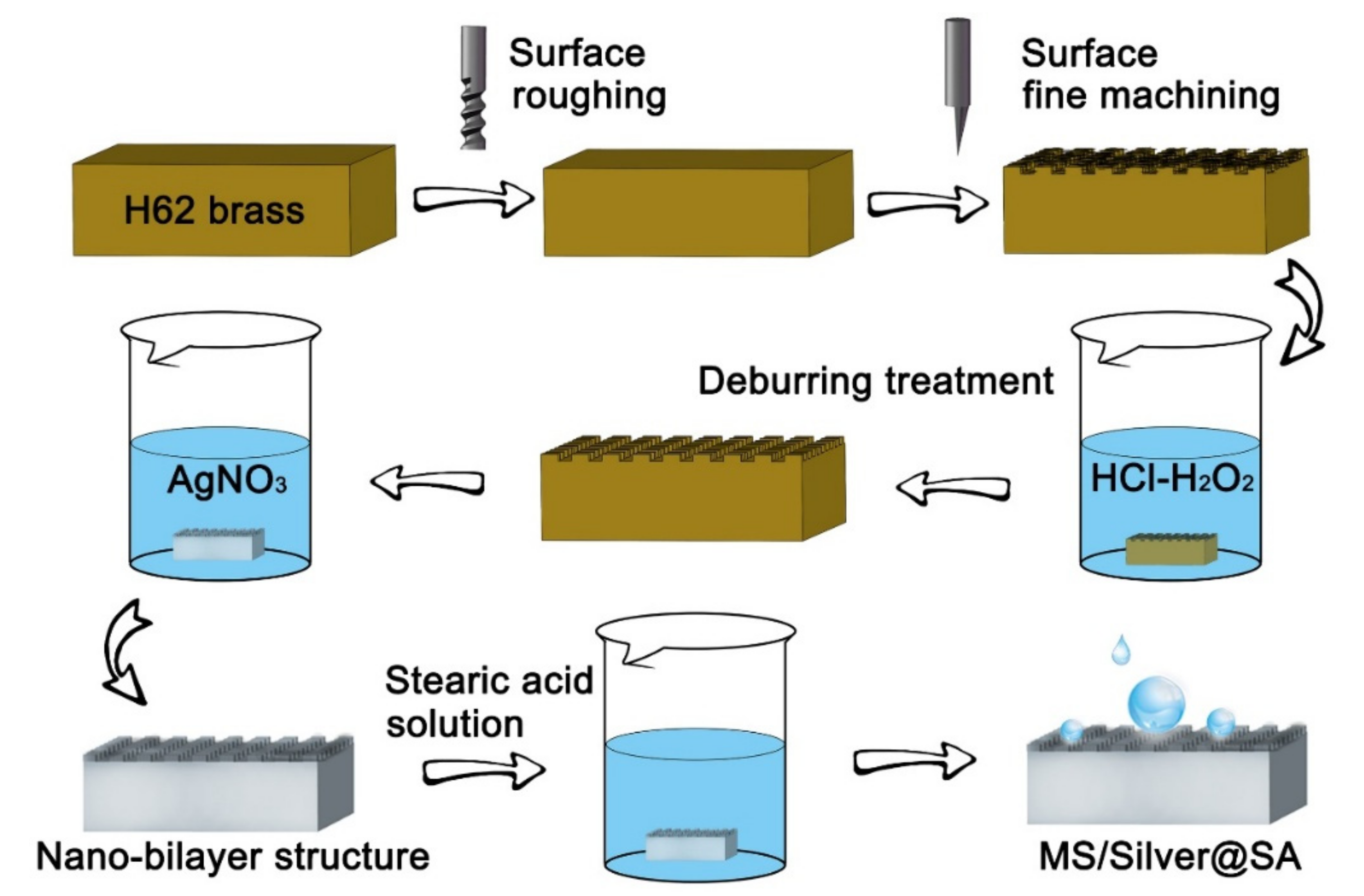
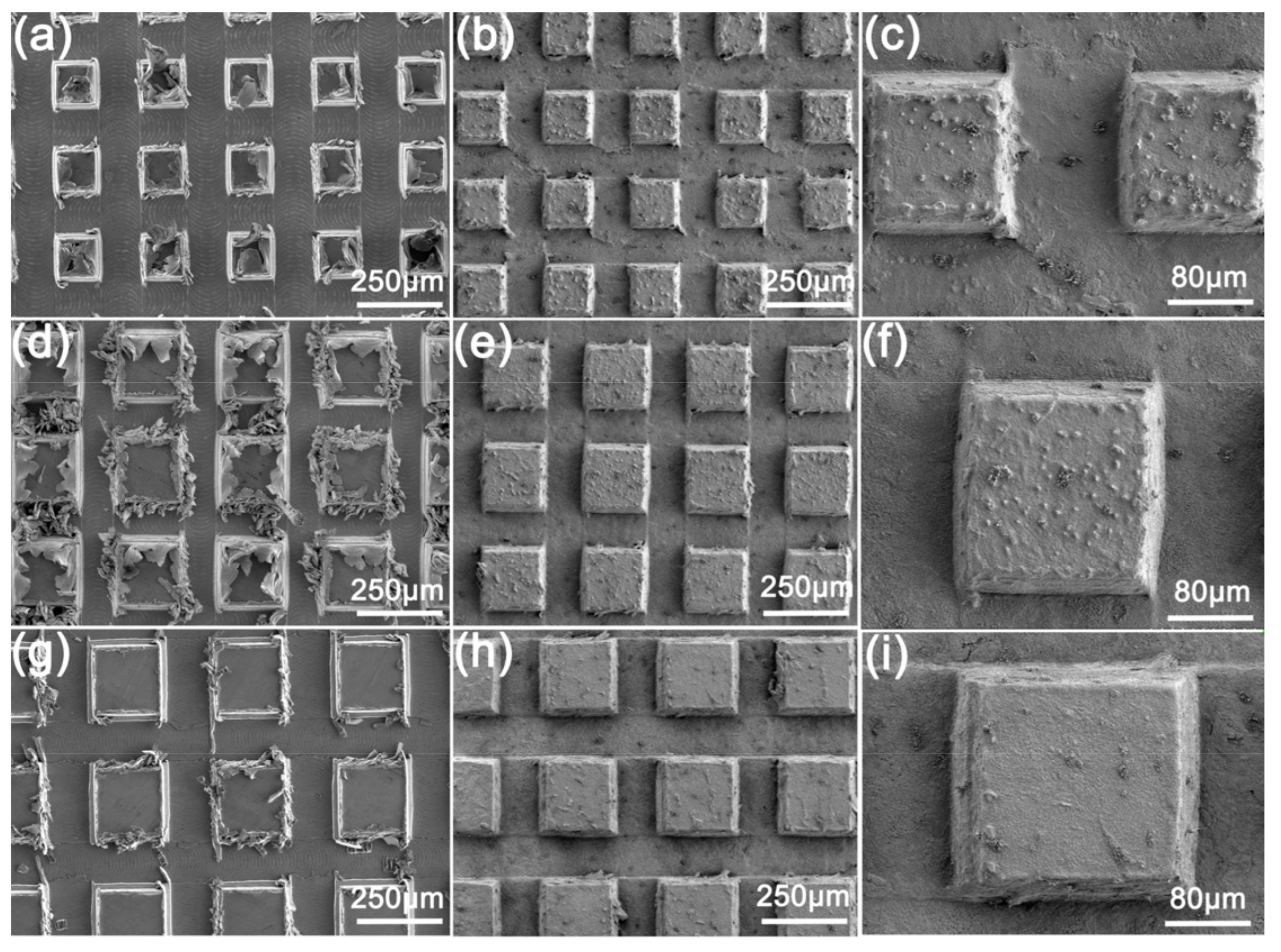


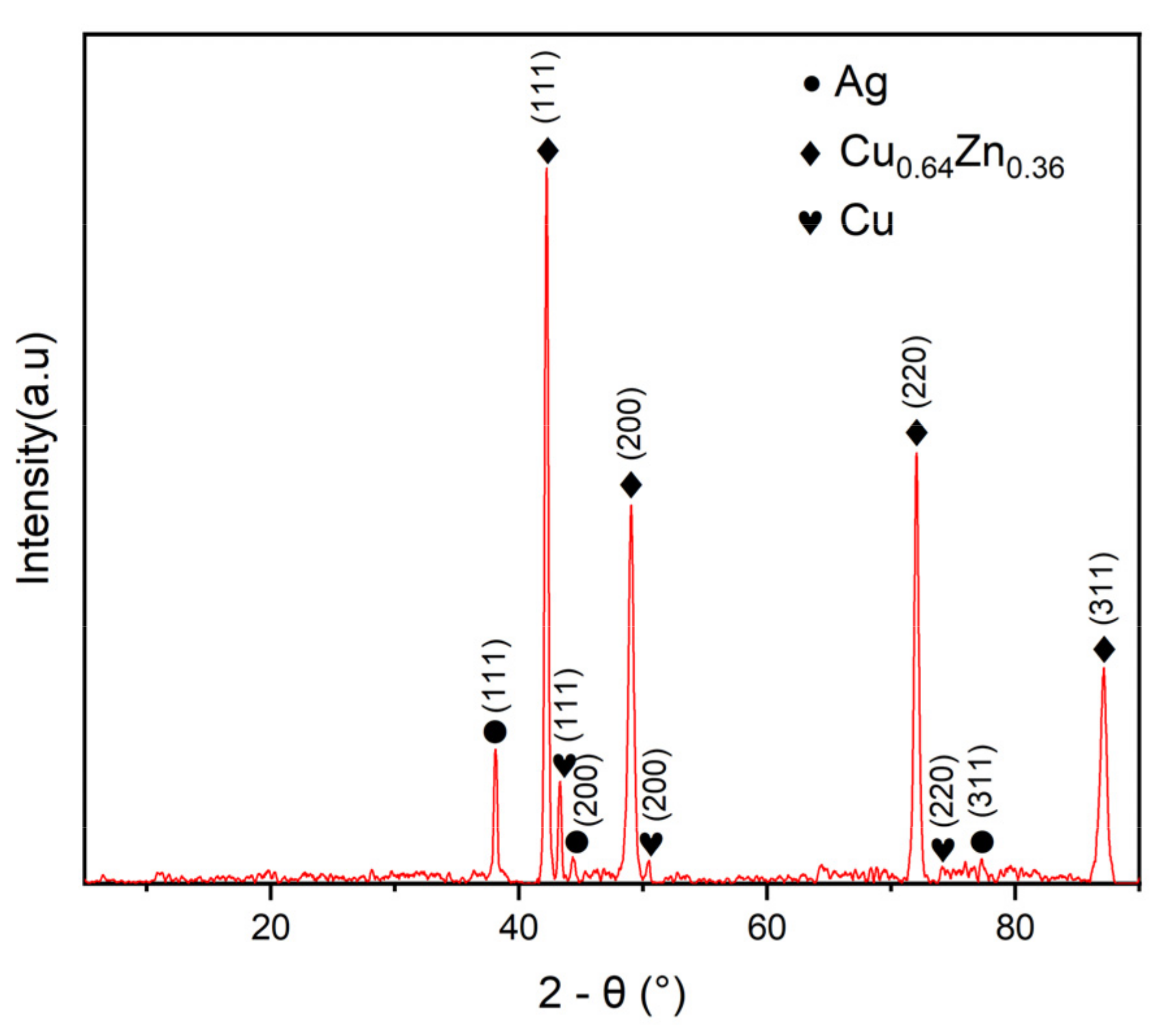
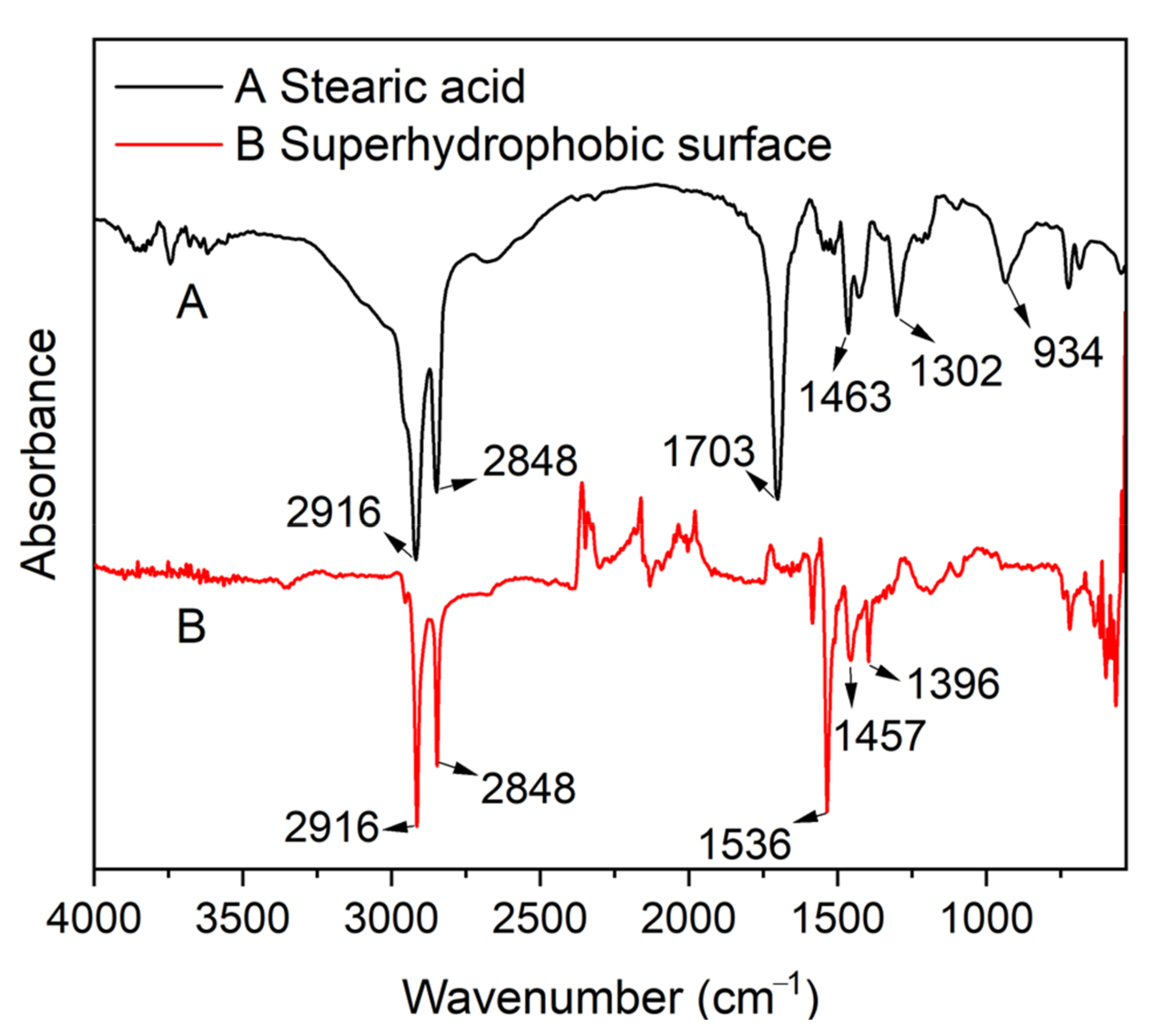
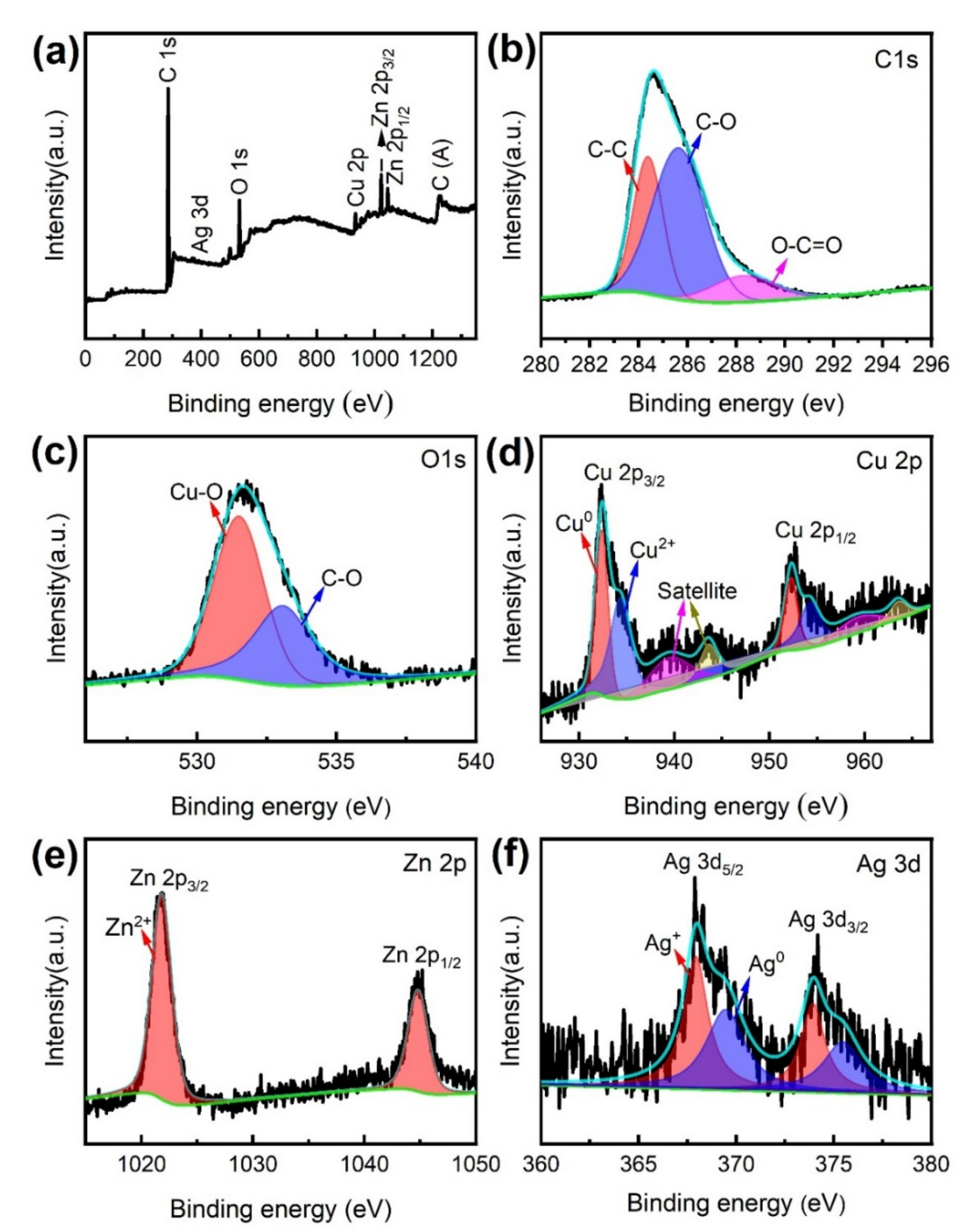


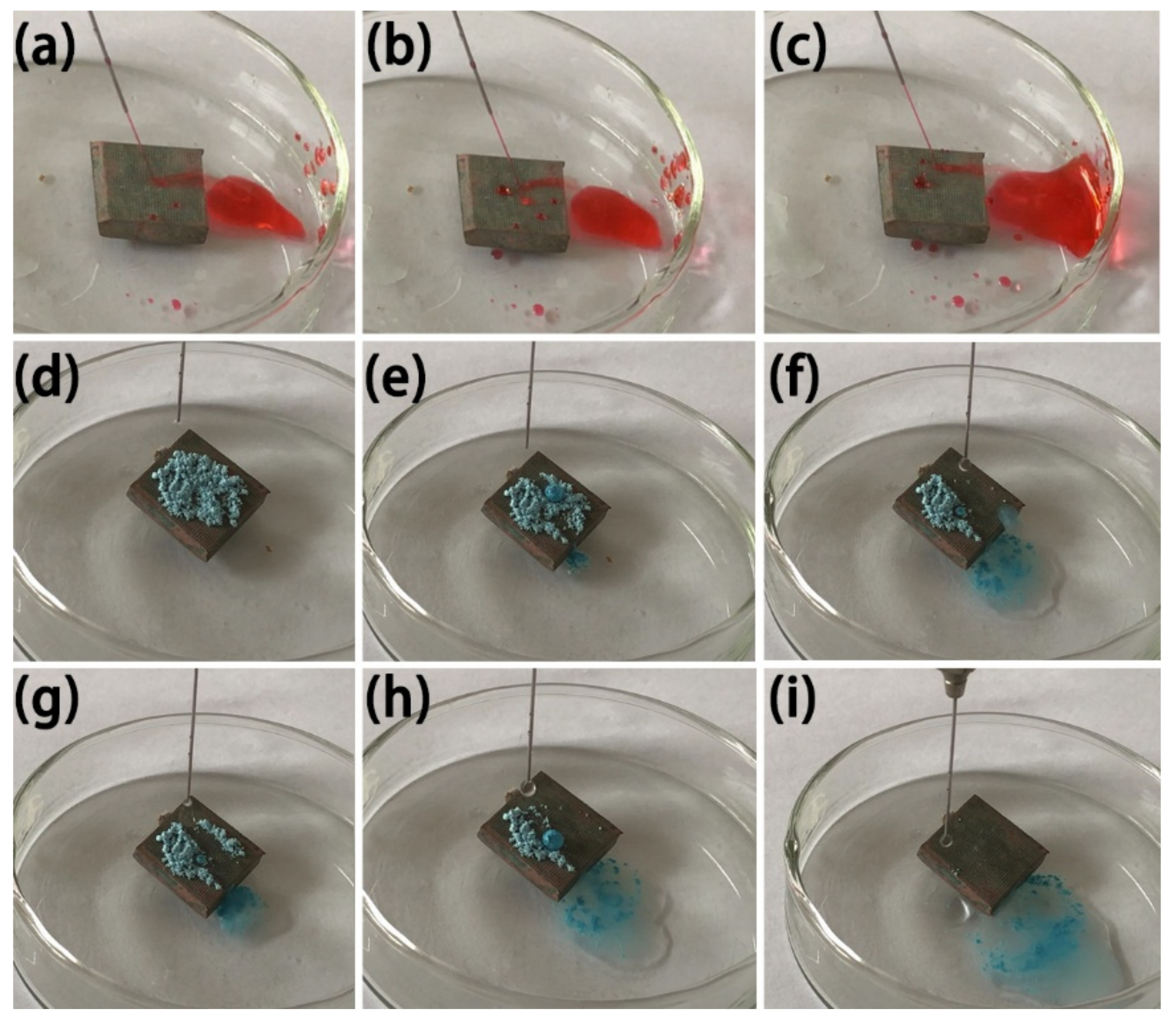

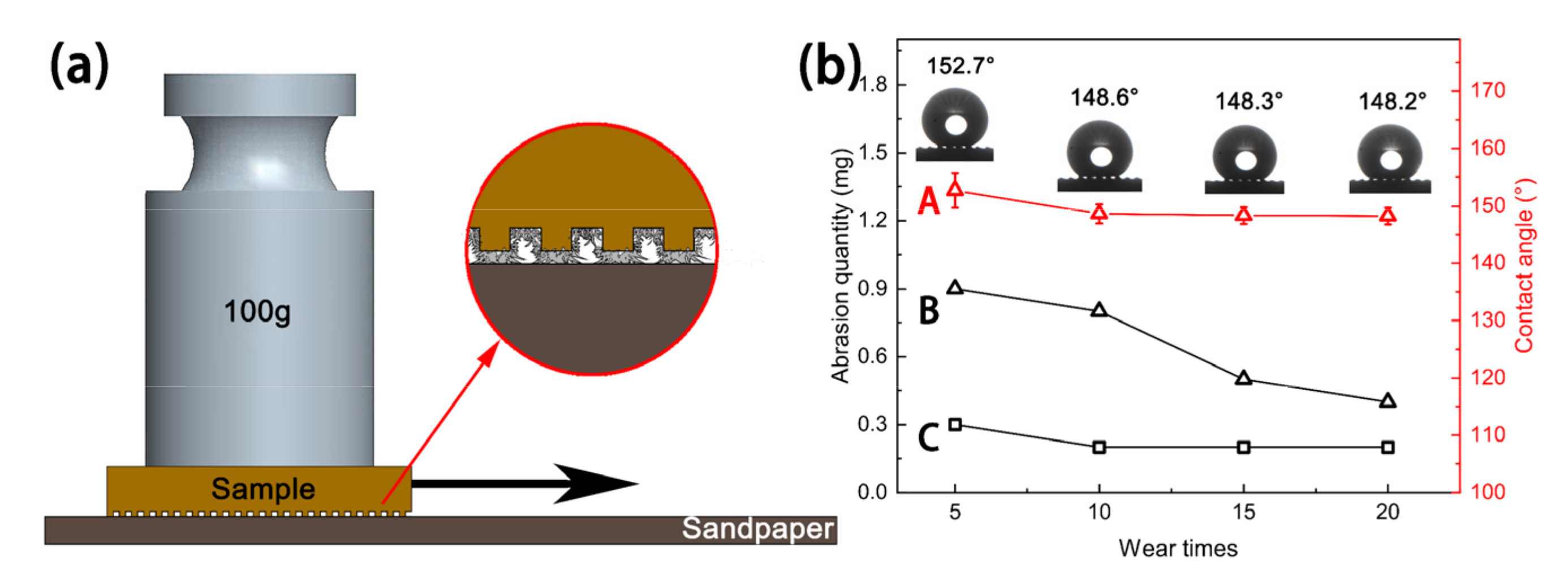
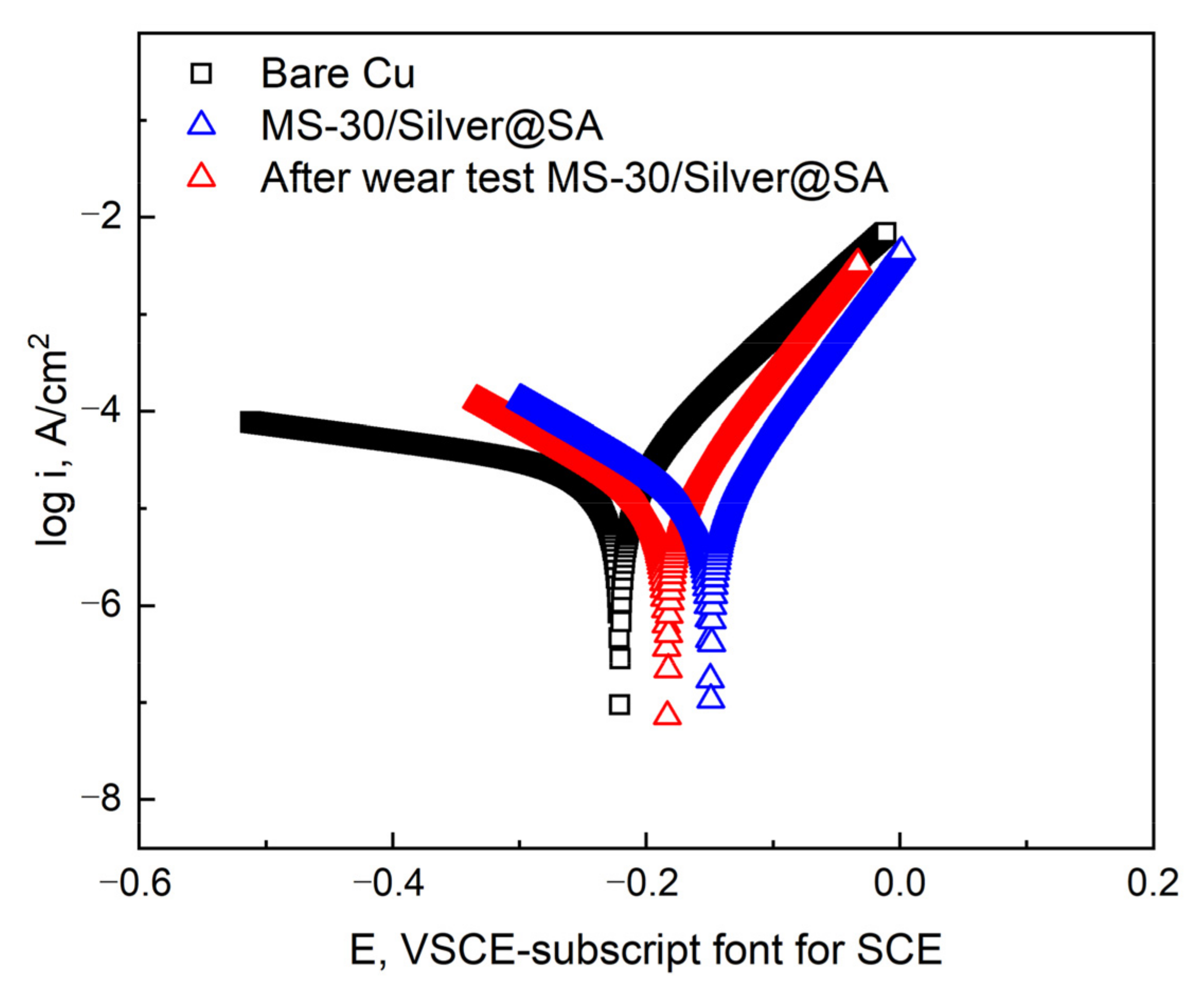
| Sample | Surface Energy (mN/m) |
|---|---|
| Bare Cu | 47.296 |
| MS-25/Silver@SA | 0.324 |
| MS-30/Silver@SA | 0.259 |
| MS-35/Silver@SA | 0.225 |
| Sample | Ecorr, VSCE-Subscript Font for SCE | Icorr (A/cm2) | Corrosion Rate (mm/a) |
|---|---|---|---|
| Bare Cu | −0.2208 | 2.92 × 10−5 | 0.3440 |
| MS-25/Silver@SA | −0.1354 | 1.80 × 10−5 | 0.2100 |
| MS-30/Silver@SA | −0.1492 | 9.87 × 10−6 | 0.1150 |
| MS-35/Silver@SA | −0.1236 | 1.88 × 10−5 | 0.2187 |
| Sample | Rs (Ω cm2) | CPEf (µF/cm2) | Rf (Ω cm2) | CPEdl (µF/cm2) | Rct (Ω cm2) |
|---|---|---|---|---|---|
| Bare Cu | 17.53 | 6.614 × 10−5 | 312.4 | 4.467 × 10−4 | 1136 |
| MS-25/Silver@SA | 12.26 | 1.103 × 10−10 | 969.9 | 3.609 × 10−7 | 7398 |
| MS-30/Silver@SA | 14.90 | 1.391 × 10−7 | 160.7 | 2.571 × 10−6 | 3864 |
| MS-35/Silver@SA | 18.45 | 4.266 × 10−5 | 107.5 | 1.438 × 10−5 | 2680 |
| Sample | Ecorr, VSCE-Subscript Font for SCE | Icorr (A/cm2) | Corrosion Rate (mm/a) |
|---|---|---|---|
| Bare Cu | −0.2208 | 2.92 × 10−5 | 0.3440 |
| MS-30/Silver@SA | −0.1492 | 9.87 × 10−6 | 0.1150 |
| After wear test MS-30/Silver@SA | −0.1832 | 1.04 × 10−5 | 0.1217 |
Publisher’s Note: MDPI stays neutral with regard to jurisdictional claims in published maps and institutional affiliations. |
© 2022 by the authors. Licensee MDPI, Basel, Switzerland. This article is an open access article distributed under the terms and conditions of the Creative Commons Attribution (CC BY) license (https://creativecommons.org/licenses/by/4.0/).
Share and Cite
Jia, C.; Zhu, J.; Zhang, L. An Anti-Corrosion Superhydrophobic Copper Surface Fabricated by Milling and Chemical Deposition. Coatings 2022, 12, 442. https://doi.org/10.3390/coatings12040442
Jia C, Zhu J, Zhang L. An Anti-Corrosion Superhydrophobic Copper Surface Fabricated by Milling and Chemical Deposition. Coatings. 2022; 12(4):442. https://doi.org/10.3390/coatings12040442
Chicago/Turabian StyleJia, Chenxi, Jiyuan Zhu, and Langping Zhang. 2022. "An Anti-Corrosion Superhydrophobic Copper Surface Fabricated by Milling and Chemical Deposition" Coatings 12, no. 4: 442. https://doi.org/10.3390/coatings12040442
APA StyleJia, C., Zhu, J., & Zhang, L. (2022). An Anti-Corrosion Superhydrophobic Copper Surface Fabricated by Milling and Chemical Deposition. Coatings, 12(4), 442. https://doi.org/10.3390/coatings12040442





